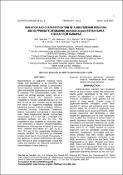Options
Isolation and characterization of a molybdenum-reducing and glyphosate-degrading klebsiella oxytoca strain saw-5 in soils from sarawak
Journal
Agrivita
Date Issued
2016
Author(s)
Sabullah M.K.
Rahman M.F.
Ahmad S.A.
Sulaiman M.R.
Shukor M.S.
Shamaan N.A.
Shukor M.Y.
DOI
10.17503/agrivita.v38i1.654
Abstract
Bioremediation of pollutants including heavy metals and xenobiotics is an economic and environmentally friendly process. A novel molyb-denum-reducing bacterium with the ability to utilize the pesticide glyphosate as a carbon source is reported. The characterization works were carried out utilizing bacterial resting cells in a microplate format. The bacterium reduces molybdate to Mo-blue optimally between pH 6.3 and 6.8 and at 34oC. Glucose was the best elec-tron donor for supporting molybdate reduction followed by lactose, maltose, melibiose, raffinose, d-mannitol, d-xylose, l-rhamnose, l-arabinose, dulcitol, myo-inositol and glycerol in descending order. Other requirements include a phosphate concentration at 5.0 mM and a molybdate concentration between 20 and 30 mM. The molybdenum blue exhibited an absorption spec-trum resembling a reduced phospho-molybdate. Molybdenum reduction was inhibited by mercury, silver, cadmium and copper at 2 ppm by 45.5, 26.0, 18.5 and 16.3%, respectively. Biochemical analysis identified the bacterium as Klebsiella oxytoca strain Saw-5. To conclude, the capacity of this bacterium to reduce molybdenum into a less toxic form and to grow on glyphosate is novel and makes the bacterium an important instrument for bioremediation of these pollutants. � 2016, Agriculture Faculty Brawijaya University. All rights reserved.
File(s)
Loading...
Name
Isolation and characterization of a molybdenum-reducing and glyphosate-degrading klebsiella oxytoca strain saw-5 in soils from sarawak.pdf
Size
620.55 KB
Format
Adobe PDF
Checksum
(MD5):ec7f8671adde53fd4025afe51cc1b9ed